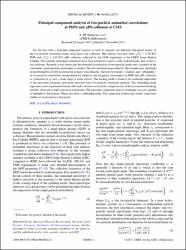| dc.contributor.author | Sirunyan, A. M. | |
| dc.contributor.author | Tumasyan, A. | |
| dc.contributor.author | Adam, W. | |
| dc.contributor.author | Ambrogi, F. | |
| dc.contributor.author | Asilar, E. | |
| dc.contributor.author | Bergauer, T. | |
| dc.contributor.author | Özdemir, Kadri | |
| dc.contributor.author | CMS Collaboration | |
| dc.date.accessioned | 2021-06-05T19:59:59Z | |
| dc.date.available | 2021-06-05T19:59:59Z | |
| dc.date.issued | 2017 | |
| dc.identifier.issn | 2469-9985 | |
| dc.identifier.issn | 2469-9993 | |
| dc.identifier.uri | https://doi.org/10.1103/PhysRevC.96.064902 | |
| dc.identifier.uri | https://hdl.handle.net/20.500.12960/802 | |
| dc.description | WOS:000417077300003 | en_US |
| dc.description.abstract | For the first time a principle-component analysis is used to separate out different orthogonal modes of the two-particle correlation matrix from heavy ion collisions. The analysis uses data from root s(NN) = 2.76 TeV PbPb and root s(NN) = 5.02 TeV pPb collisions collected by the CMS experiment at the CERN Large Hadron Collider. Two-particle azimuthal correlations have been extensively used to study hydrodynamic flow in heavy ion collisions. Recently it was shown that the expected factorization of two-particle results into a product of the constituent single-particle anisotropies is broken. The new information provided by these modes may shed light on the breakdown of flow factorization in heavy ion collisions. The first two modes ("leading" and "subleading") of two-particle correlations are presented for elliptical and triangular anisotropies in PbPb and pPb collisions as a function of p(T) over a wide range of event activity. The leading mode is found to be essentially equivalent to the anisotropy harmonic previously extracted from two-particle correlation methods. The subleading mode represents a new experimental observable and is shown to account for a large fraction of the factorization breaking recently observed at high transverse momentum. The principle-component analysis technique was also applied to multiplicity fluctuations. These also show a subleading mode. The connection of these new results to previous studies of factorization is discussed. | en_US |
| dc.language.iso | eng | en_US |
| dc.publisher | Amer Physical Soc | en_US |
| dc.relation.ispartof | Physical Review C | en_US |
| dc.rights | info:eu-repo/semantics/openAccess | en_US |
| dc.subject | Fizik | en_US |
| dc.subject | Physics | en_US |
| dc.title | Principal-component analysis of two-particle azimuthal correlations in PbPb and pPb collisions at CMS | en_US |
| dc.type | article | en_US |
| dc.authorid | 0000-0002-0103-1488 | |
| dc.department | Mühendislik Fakültesi, Elektrik-Elektronik Mühendisliği Bölümü | en_US |
| dc.contributor.institutionauthor | Özdemir, Kadri | |
| dc.identifier.doi | 10.1103/PhysRevC.96.064902 | |
| dc.identifier.volume | 96 | en_US |
| dc.identifier.issue | 6 | en_US |
| dc.relation.publicationcategory | Makale - Uluslararası Hakemli Dergi - Kurum Öğretim Elemanı | en_US |

















